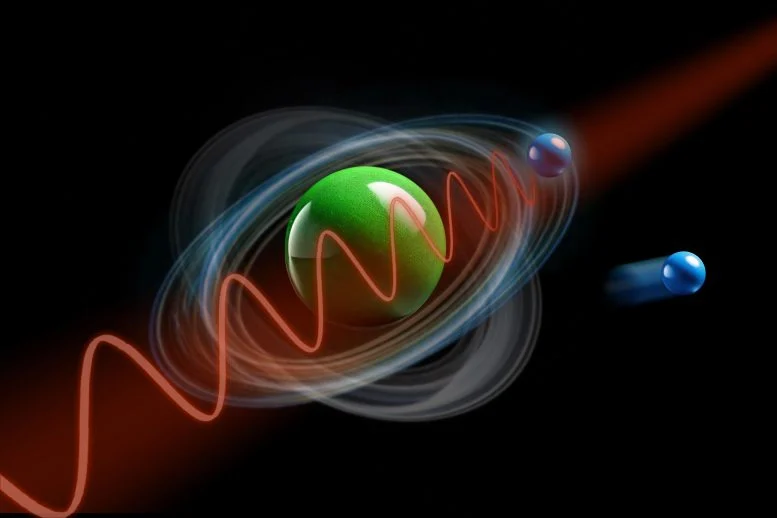
By Vienna University of Technology October 24, 2024
Collected at: https://scitechdaily.com/how-fast-is-quantum-entanglement-scientists-clock-the-speed-of-the-instantaneous/
Scientists have developed simulations to investigate the rapid processes of quantum theory, revealing insights into quantum entanglement and its formation.
These findings, which detail how entanglement can be quantified and observed within attoseconds, demonstrate significant advances in understanding the temporal dynamics of quantum events.
Quantum Theory and Time: Unraveling Instantaneous Effects
Quantum theory deals with events that occur on incredibly short time scales. In the past, these events were thought to happen instantaneously, with no time in between: an electron orbits the nucleus of an atom and, in the blink of an eye, it’s suddenly ejected by a flash of light. Similarly, two particles collide and are immediately ‘quantum entangled.’
Today, however, scientists can study the exact timing of these nearly instantaneous effects. Researchers from TU Wien (Vienna), in collaboration with teams from China, have developed computer simulations to explore these ultrafast processes. These simulations allow us to understand how quantum entanglement forms in mere attoseconds. Their findings have been published in the journal Physical Review Letters.
An attosecond is an extremely small fraction of time, lasting just one quintillionth (one billionth of a billionth, or 10-18) of a second. It’s often used to measure ultrafast phenomena in quantum physics, such as the movement of electrons within atoms.
Quantum Entanglement Explained
If two particles are quantum entangled, it makes no sense to describe them separately. Even if you know the state of this two-particle system perfectly well, you cannot make a clear statement about the state of a single particle. “You could say that the particles have no individual properties, they only have common properties. From a mathematical point of view, they belong firmly together, even if they are in two completely different places,” explains Prof. Joachim Burgdörfer from the Institute of Theoretical Physics at TU Wien.
In experiments with entangled quantum particles, scientists are usually interested in maintaining this quantum entanglement for as long as possible – for example, if they want to use quantum entanglement for quantum cryptography or quantum computers. “We, on the other hand, are interested in something else – in finding out how this entanglement develops in the first place and which physical effects play a role on extremely short time scales,” says Prof. Iva Březinová, one of the authors of the current publication.
Quantum Birth Times and Entanglement
The researchers looked at atoms that were hit by an extremely intense and high-frequency laser pulse. An electron is torn out of the atom and flies away. If the radiation is strong enough, it is possible that a second electron of the atom is also affected: It can be shifted into a state with higher energy and then orbit the atomic nucleus on a different path.
So after the laser pulse, one electron flies away and one remains with the atom with unknown energy. “We can show that these two electrons are now quantum entangled,” says Joachim Burgdörfer. “You can only analyze them together – and you can perform a measurement on one of the electrons and learn something about the other electron at the same time.”
Measurement and Mystery in Quantum Physics
The research team has now been able to show, using a suitable measurement protocol that combines two different laser beams, that it is possible to achieve a situation in which the ‘birth time’ of the electron flying away, i.e. the moment it left the atom, is related to the state of the electron that remains behind. These two properties are quantum entangled.
“This means that the birth time of the electron that flies away is not known in principle. You could say that the electron itself doesn’t know when it left the atom,” says Joachim Burgdörfer. “It is in a quantum-physical superposition of different states. It has left the atom at both an earlier and a later point in time.”
Which point in time it ‘really’ was cannot be answered – the ‘actual’ answer to this question simply does not exist in quantum physics. But the answer is quantum-physically linked to the – also undetermined – state of the electron remaining with the atom: If the remaining electron is in a state of higher energy, then the electron that flew away was more likely to have been torn out at an early point in time; if the remaining electron is in a state of lower energy, then the ‘birth time’ of the free electron that flew away was likely later – on average around 232 attoseconds.
This is an almost unimaginably short period of time: an attosecond is a billionth of a billionth of a second. “However, these differences can not only be calculated, but also measured in experiments,” says Joachim Burgdörfer. “We are already in talks with research teams who want to prove such ultrafast entanglements.”
Resolving the Quantum Conundrum
The work shows that it is not enough to regard quantum effects as ‘instantaneous’: Important correlations only become visible when one manages to resolve the ultra-short time scales of these effects. “The electron doesn’t just jump out of the atom. It is a wave that spills out of the atom, so to speak – and that takes a certain amount of time,” says Iva Březinová. “It is precisely during this phase that the entanglement occurs, the effect of which can then be precisely measured later by observing the two electrons.”
Reference: “Time Delays as Attosecond Probe of Interelectronic Coherence and Entanglement” by Wei-Chao Jiang, Ming-Chen Zhong, Yong-Kang Fang, Stefan Donsa, Iva Březinová, Liang-You Peng and Joachim Burgdörfer, 15 October 2024, Physical Review Letters.
DOI: 10.1103/PhysRevLett.133.163201

Leave a Reply